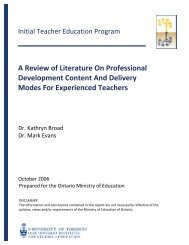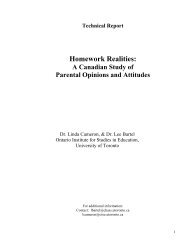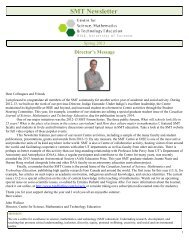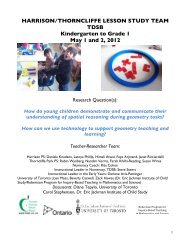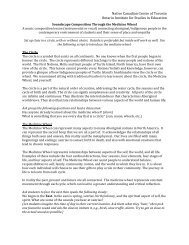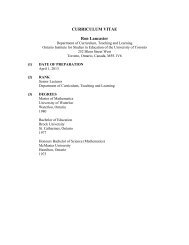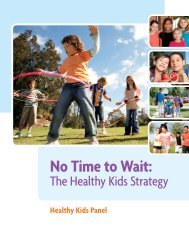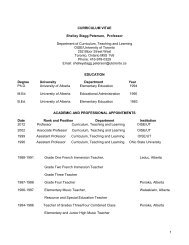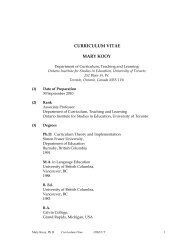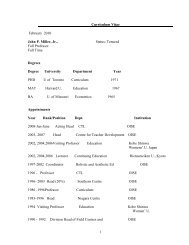The Ontario Curriculum, Grades 9-12 - Ministère de l'éducation ...
The Ontario Curriculum, Grades 9-12 - Ministère de l'éducation ...
The Ontario Curriculum, Grades 9-12 - Ministère de l'éducation ...
You also want an ePaper? Increase the reach of your titles
YUMPU automatically turns print PDFs into web optimized ePapers that Google loves.
Note: Many of the health problems that affect Aboriginal peoples are related to environmental<br />
issues (e.g., water quality, pollution).<br />
– explain Aboriginal and non-Aboriginal perspectives on a specific treaty right (e.g.,<br />
fishing rights, hunting rights, logging rights)<br />
Aboriginal Beliefs, Values, and Aspirations in Contemporary<br />
Society, Gra<strong>de</strong> 11, College Preparation (NBV3C)<br />
I<strong>de</strong>ntity<br />
– explain specific environmental influences (e.g., salmon migration on the Northwest<br />
Coast; caribou migration for the Dene people, utilization of forests and lakes by the<br />
Ojibway and Cree communities) on the social and cultural i<strong>de</strong>ntity of Aboriginal peoples<br />
– <strong>de</strong>monstrate an un<strong>de</strong>rstanding of how Aboriginal peoples’ i<strong>de</strong>ntity as custodians and<br />
protectors of the land entrusted to them by the Creator (e.g., as expressed in the<br />
thanksgiving address) inspires their historical and contemporary commitment to<br />
remaining on their lands (e.g., as reflected in their negotiation of treaties such as the<br />
Maritimes Treaty of 1752 and Treaty No. 11)<br />
– <strong>de</strong>scribe how Aboriginal practices, behaviours, beliefs, and symbols (e.g., hunting and<br />
fishing traditions; ceremonies and feasts; the use of drums, music, and dance) strengthen<br />
Aboriginal cultural i<strong>de</strong>ntities<br />
Relationships<br />
• explain how Aboriginal peoples’ relationship to the land traditionally sustained them in<br />
various environments across Canada<br />
• explain how Aboriginal peoples’ links to the land and to a sustainable environment are part<br />
of their cultural i<strong>de</strong>ntity<br />
– i<strong>de</strong>ntify customs, ceremonies, and spiritual beliefs that connect Aboriginal peoples to<br />
nature and to one another (e.g., hunters’ respect for animal bones, drumming, dream<br />
interpretations, traditional roles of family members in different Aboriginal cultures)<br />
– i<strong>de</strong>ntify examples of art, architecture, and artifacts that <strong>de</strong>pict a spiritual and emotional<br />
link between Aboriginal peoples and their traditional lands (e.g., totem pole carvings;<br />
masks; <strong>de</strong>signs of cultural centres; artwork of Daphne Odjig, Maxine Noel, and Joane<br />
Cardinal Schubert)<br />
– <strong>de</strong>monstrate an un<strong>de</strong>rstanding of traditional Aboriginal activities associated with the<br />
seasonal cycle<br />
– <strong>de</strong>scribe how the spiritual relationship that Aboriginal peoples have with the land is<br />
integrated with their beliefs and values (e.g., the Aboriginal belief that many parts of<br />
nature have spirits)<br />
– compare harvesting behaviours and beliefs of Aboriginal and non-Aboriginal peoples<br />
(e.g., wild rice harvesting, fishing practices on the east and west coasts of Canada)<br />
92 Environmental Education, <strong>Gra<strong>de</strong>s</strong> 9−<strong>12</strong>: Scope and Sequence of Expectations, 2011



